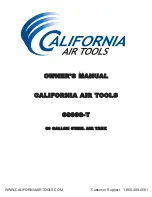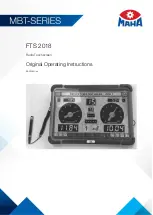
9
Customer Support: 1-866-409-4581
MAINTENANCE
Draining the Air Tank
The frequency at which you should drain the air tank depends on
the environmental conditions and the amount of operating time
logged.
Highly recommended to manually drain the air tank regularly
from the ball drain valve to remove excess water.
Draining the air tank protects parts from rust and corrosion.
Testing for Leaks
Make sure all connections are tight. Do not overtighten.
A small leak in any hose or pipe connection will reduce the air
compressor's performance.
To test for small leaks, spray a small amount of soapy water on
the area suspected of leaking. If the soap bubbles, replace the
broken part.
Cleaning
Clean items with a soft brush, or wipe with a moistened cloth
using a biodegradable solvent.
Do not use flammable liquids such as gasoline or alcohol. Always
keep parts clean from dirt and dust for better performance.
STORAGE
Before storing for a prolonged period of time:
1.
Turn off the power supply.
2.
Disconnect the power cord from the power supply.
3.
Release all of the pressure and moisture from the air tank
through the manual drain valve.
4.
Clean the air compressor to remove all dirt and dust.
5.
Cover the air compressor with a cover to protect the unit from
dust and moisture.
6.
Do not stack or store any items on top of or around the air
compressor. Damage could occur.
Flying objects can cause injury to the eyes, head and
other parts of the body.
Air-powered equipment and power tools are capable
of propelling items (metal chips, fasteners and
particulates) at high speed into the air and could
result in injury.
Always wear approved head and eye protection.
Never point the air stream at any part of your body,
or at another person or animal.
When operating the air compressor, make sure all
other people and animals maintain a safe distance.
Do not move the air compressor when the air tank is
under pressure.
Never use the air hoses to pull or move the air
compressor.
Keep the air compressor on a flat surface.
WARNING
FLYING OBJECTS





























